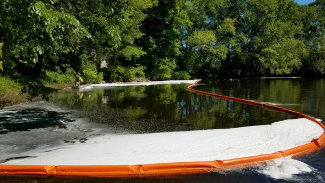PFAS
What Are PFAS and Why Are They an Issue?
Per- and polyfluoroalkyl substances (PFAS) are a class of approximately 5,000 anthropogenic fluorinated chemicals whose presence in the environment is becoming of significant interest both in the United States and abroad. PFAS have been used since the 1940s in numerous industrial and residential products such as Aqueous Film Forming Foam (AFFF) for firefighting, metal plating, food packaging, specialty surfactants, non-stick cookware, water-resistant fabrics, and others.
Understanding release mechanisms and pathways, assessment strategies, fate and transport, and remediation of PFAS continues to prove to be challenging. PFAS is found somewhat ubiquitous in nature, from military installations, sewage treatment facilities, drinking water wells, and even in air. Some PFAS, such as perfluorooctanoic acid (PFOA) and perfluorooctane sulfonate (PFOS), are thought to be recalcitrant and bioaccumulate, thus posing potential significant impacts to humans and the environment. Ongoing toxicological work indicates PFAS exposure may have suggestive carcinogenic potential while other studies potentially link PFAS to elevated cholesterol levels, immune system response and function, low birth weight, and others (ITRC, 2018).
PFAS owe their recalcitrant nature to their chemical structure, which is commonly defined as being a “two-part” chemical. The first part, referred to as the “tail”, is comprised of covalently bonded carbon and fluorine. This carbon-fluorine bond is known to be one of the strongest in nature, due to the large differences in electronegativity between carbon and fluorine. The “head” consists of a functional group such as a carboxylic or sulfonic acid, typically found in nature as a negatively charged anion. Together, the head and the tail give PFAS its remarkable hydrophobic and hydrophilic properties.
How Can EEC Help?
EEC has extensive experience in dealing with emerging contaminants, such as PFAS, and the challenges they bring. Over the years, EEC has successfully helped its clients deal with emerging contaminants, such as hexavalent chromium, 1,4-dioxane, and perchlorate, and has developed comprehensive cost-effective site investigation and remedial solutions. With the evolving nature of emerging contaminant issues, EEC remains at the forefront by keeping up to date with current regulatory issues, such as the development of health advisory/notification levels and testing for PFAS in drinking water, issuance of investigative orders for corrective action and site investigation, development of testing protocols in drinking water and groundwater, and evaluating treatment technologies to remove PFAS from water.
EEC is committed to assisting its clients with potential upcoming issues with PFAS. Whether it’s groundwater, surface water, or drinking water sampling; or developing the best treatment approach for cleanup, EEC’s team of highly experienced scientists, geologists, and engineers have the capability to address the emerging issues revolving around PFAS.
EEC’s Services for PFAS:
- Feasibility studies for PFAS removal in water, wastewater, and leachate
- Owners agent / Owners Advisor for water purveyors
- Subsurface investigation and sampling of soil, sediments and groundwater
- Historical research and source identification
- Plume evaluation and modeling
- Remedial design and treatment of soil, sediments, and groundwater
- Industrial wastewater treatment
- Aerially deposited PFAS studies
- Installation of remediation systems




